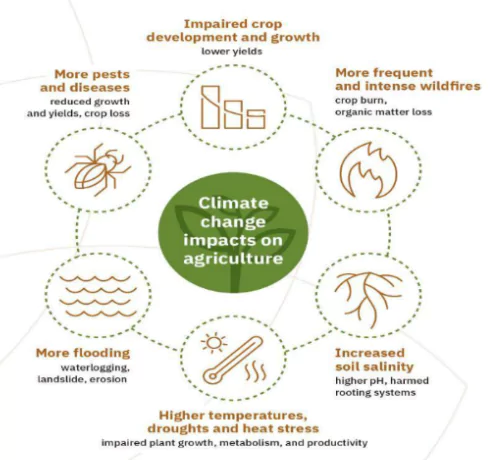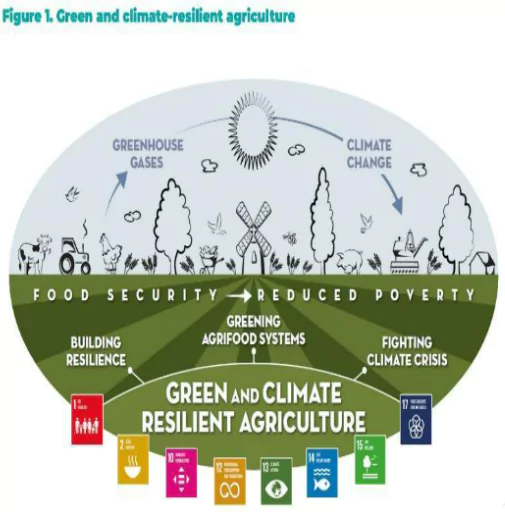Answer:
|
How to Approach the Question?
- Introduction
- Start with the definition of climate-resilient agriculture and an example. (You can also provide the context of climate change before definition).
- Body
- Describe the basic traits of climate-resilient agriculture.
- Provide some key policy interventions that are required to address the impacts of climate change on agriculture.
- Conclusion
- Highlight the significance of climate-resilient agriculture amidst the escalating environmental concerns and end with a futuristic note.
|
Introduction
Amidst the present era of climate change, agriculture faces significant threats worldwide, underscoring the urgency of climate-resilient practices. Climate-resilient agriculture fortifies farming systems against climate change impacts, emphasizing sustainability while bolstering productivity, food security, and livelihoods. As an illustration, “Conservation Agriculture” (CA) integrates reduced tillage, soil cover, and diverse crop rotations, enhancing soil health, water retention, and nutrient availability to withstand droughts and extreme weather.
Body
Traits of Climate-Resilient Agriculture:

- Diversification of Crops and Livestock: Planting a variety of crops and raising different types of livestock spreads risk, ensuring that if one crop or animal is affected by changing climate conditions, others can compensate. For instance, farmers in Bangladesh practice mixed cropping of rice, fish, and vegetables, enhancing income and food security.
- Water Management and Efficiency: Efficient water management minimizes waste and ensures sustainable use of water resources, crucial for agriculture’s resilience to changing precipitation patterns, as illustrated by the practice of “System of Rice Intensification” (SRI) in Madagascar.
- Soil Health Improvement: Enhancing soil health through practices like reduced tillage and organic matter addition improves its ability to retain water and nutrients, making crops more resilient to drought and extreme weather, as exemplified by the cover cropping and no-till practices in the USA.
- Integrated Pest Management (IPM): Balancing chemical, biological, and cultural methods minimizes pesticide use. In Vietnam, farmers release predatory insects to control pests in rice fields, reducing chemical dependency.
- Climate-Adapted Crop Varieties: Planting crop varieties that are specifically bred to withstand climate challenges like heat, drought, and pests increases agricultural resilience and ensures consistent yields, exemplified by the adoption of “Golden Rice” in Asia. It is genetically modified to contain Vitamin A, addresses nutrient deficiencies and improves food security in regions susceptible to climate-related crop losses.
- Agroforestry and Biodiversity Conservation: Combining trees, crops, and livestock on the same land diversifies production, improves soil fertility, and provides a buffer against climate impacts. For instance, in Cameroon, cocoa farmers integrate shade trees into their plantations, creating microclimates that protect cocoa plants from temperature extremes and support biodiversity.
- Risk Management and Early Warning Systems: Implementing strategies to anticipate, monitor, and respond to climate-related risks through early warning systems enables timely actions to reduce vulnerabilities, as demonstrated by the project “Participatory Integrated Climate Services for Agriculture” in Uganda.
- Capacity Building and Knowledge Sharing: Educating farmers about climate-smart practices empowers them to adapt effectively to changing conditions, fostering self-reliance and resilience. For instance, the “Farmers’ Field School” approach in Indonesia trains farmers in techniques such as intercropping and soil conservation, building their capacity to cope with climate uncertainties.
Key Policy Interventions for Addressing Climate Change Impacts on Agriculture:

- Climate-Resilient Infrastructure Development: Investing in climate risk-reducing infrastructure, like flood defenses and water storage, can safeguard agricultural productivity and farmer livelihoods, as illustrated by India’s “National Rural Drinking Water Program”.
- Subsidies for Climate-Resilient Inputs: Offering financial incentives or subsidies for climate-resilient inputs spurs farmers to embrace practices bolstering agricultural resilience, as seen through the European Union’s “Common Agricultural Policy,” which grants subsidies to farmers adopting sustainable methods such as crop rotation and agroecological farming.
- Crop Insurance and Risk Transfer Mechanisms: Crop insurance schemes are crucial for shielding farmers from climate-related crop losses and alleviating financial vulnerabilities, as demonstrated by Kenya’s “Kilimo Salama” program.
- Research and Extension Services: Government-sponsored research and extension services must be prioritized to equip farmers with expertise in climate-resilient methods and technologies, as exemplified by Zambia’s “Climate Change Adaptation and Agribusiness Support Program,” focused on researching resilient crops and training farmers in cultivation techniques.
- Climate-Smart Land Use Planning: Incorporating climate factors into land use planning can ensure robust agriculture, reducing climate vulnerability. Mongolia’s “Land Degradation Neutrality Fund” backs initiatives like reforestation and soil conservation, exemplifying support for sustainable land management.
- Water Management and Irrigation Policies: In response to changing water availability driven by climate change, adopting policies that prioritize sustainable water management becomes a crucial solution. Notably, Australia’s “Water Efficiency Program” exemplifies this approach by investing in upgrading irrigation systems.
- Disaster Preparedness and Emergency Response Plans: Creating robust plans swiftly safeguards farmers and assets in extreme weather. For instance, the Philippines’ “National Disaster Risk Reduction and Management Plan” outlines measures like livestock evacuation and emergency aid for farmers during typhoons and floods.
- Promoting Climate Resilient Crops: Comprehensive initiatives similar to India’s approach should be prioritized to promote climate resilient crops, exemplified by the designation of 2023 as the International Year of Millets and the implementation of targeted programs like Odisha’s Millet Mission, aiming to reinforce food security and agricultural sustainability amidst the challenges posed by shifting climate dynamics.
Conclusion
Amidst escalating environmental concerns, climate-resilient agriculture has gained pivotal importance. Its traits, from diversified crops to disaster readiness, offer a beacon of hope, fortifying productivity, food security, and livelihoods while diminishing climate vulnerabilities. Through sustainable practices and innovative policies, a promising and innovative future emerges, where agriculture not only counters risks but embraces resilience in the face of challenges.
To get PDF version, Please click on "Print PDF" button.



Latest Comments